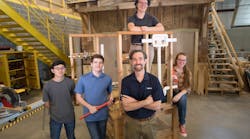Four students at Elizabethtown College in PA recently won accolades for a brilliant idea that materialized in the form of a “plumbing trainer” designed to advance understanding of basic plumbing practices in an educational, classroom setting.
“ETown” College mechatronics engineering student Steven Klinefelter, class of ’25, said that of all the possible ideas they had to pursue for the college project—a requirement for graduation—they settled on the plumbing trainer.
The earliest ideas for the trainer began at another school—Elizabethtown High School, only a mile from the college campus. Teachers for the high school’s construction curriculum asked if the college could develop a training aid. The project request ended up being a good fit for the college’s community-based program, and for presentation during the “SCAD” event; that is, the college’s Scholarship and Creative Arts Day.
“The students who were involved poured their skills and creativity into [the plumbing trainer] from the beginning,” said Randy Doxzon, director of plumbing/pipefitting and apprentice resource development for Associated Builders and Contractors (ABC), Keystone Chapter, based in Manheim, PA. “It was a real pleasure helping them work on it.”
Involved with the project were students Olivia Kurtz, engineering, Paige Parsons, engineering, architecture and math. Toma Yasuda (all three members of the class of ’24) and Klinefelter.
Industry Partners
Klinefelter explained that the trainer was conceived as both a conceptual and hands-on device for students to learn and practice basic plumbing.
Paige Parsons, who’s worked on her family’s dairy farm for more than a decade said that, in a way, she went into the project with some “plumbing” experience of a different form—that is, Holstein milk piping, distribution and storage—and she was glad to be involved.
The manufacturer’s representative firm for Watts, Warminster, PA-based Vernon Bitzer Associates (VBA)—already a valued industry partner with the Keystone chapter of ABC—learned about the project and eagerly offered to help. VBA managers and Watts Water Technologies donated a wide variety of plumbing technologies for use in the project’s development.
Truly Unique
Doxzon, whose experience and intensity are focused on improving trade skills, said that “thousands of students acquire valuable, hands-on experience at ABC chapters each year. In my experience, this project was 100 percent unique. The trainer has the potential of becoming invaluable for basic plumbing training in a broader, national fashion.”
And Doxzon should know. His responsibilities at ABC also include curriculum development. He routinely works with ABC and allied groups who conduct career days and career fairs for students and the construction industry.
Kurtz and Yasuda explained that the plumbing trainer consists of a an in-line 10-micron sediment filter housing, backflow preventer and a PVC drainpipe with connections for a p-trap and sink.
“Our goal was to design a plumbing trainer for a construction class at Elizabethtown Area High School,” explained Kurtz. “It was composed of four main parts: two physical trainers, activities for the trainers, lessons, and lesson plans to prove that the activities met state standards. We also provided an exploratory introduction to plumbing as a potential career.
“Previously, there was no means at the high school to provide a training tool to teach plumbing techniques; that’s why our design was tailored to meet the need,” she added. “We relied heavily on the input of local plumbers, so the activities provide an accurate representation of necessary skills. Gaining multiple perspectives from tradesmen was crucial to the success of our project. The trainer, made of 2x4 frame, includes PEX, PVC and brass fittings. It’s also interactive so that two students can work with them simultaneously. The trainers contain a water filter, washer box, backflow preventer and drainpipe—that connects to a utility sink. These activities were chosen to provide exposure while minimizing overall cost.”
When the project was underway, the students designed the trainer with the help of CAD technology (Autodesk Inventor), provided by the college and guided by Doxzon while on MS Teams.
With care, the college students designed closely consulting IAPMO’s 2019 Uniform Plumbing Code (UPC) to validate the components and their precise arrangement within the trainer model. The students also were guided by IAPMO plumbing book. Doxzon also provided guidance in interpreting and applying applicable codes. The students also developed development an activity and training booklet designed to guide use of the trainer.
“An important message for future users of the plumbing trainer is that the booklet, in tandem with the trainer, are intellectual concepts that have real outreach potential,” said Kiscaden.
“Outreach for who?” you might ask. Well, anyone who wants to learn the basics of plumbing but might have “conceptual blockage” when confronted exclusively with written, especially technical, information. If a picture’s worth a thousand words, just consider the value of this simple model; it covers a lot of ground.
A 'Best of' Project
The students received a stellar grade for the project. The plumbing trainer also won the college's "Recognition of Excellence and Professional Potential" achievement, which is awarded to one outstanding sophomore project each year.
“The goal was to design a trainer to introduce high school students, or those new to the trade, to the fundamentals of plumbing, and to allow them to connect with local plumbing businesses,” said Klinefelter.
Watts and VBA donated materials, and Doxzon assisted the students with the trainer’s design and construction. “Linking business to education is one of the many ways ABC Keystone recruits the next generation of industry professionals,” said Doxzon. “It’s still too early to see what happens as a result of this project, but the potential is really good.”
“The project was just too good for me pass up,” added Kiscaden. “Considering my connections to both schools, and the direct-hit applicability to my role at Watts—one of the plumbing industry’s giants—brought everything together so remarkably.”
The students worked under the direction Elizabethtown College staff members Dr. Mark Brinton, assistant professor of engineering and physics; Dr. Brenda Read-Daily, associate professor of engineering; and Stephanie Zegers, MSL, assistant director of engineering and industry liaison.
ABC, founded in Baltimore in 1950, is a national construction industry trade association representing more than 22,000 members in 68 chapters. Today, ABC represents all specialties within the U.S. construction industry and is comprised primarily of firms that perform work in the industrial and commercial sectors.
“This was an exciting project and I wanted to again extend my congratulations to everyone who was involved. For me, the most thrilling portion was the addition of a residential backflow preventer into the design,” Kiscaden said.
“Our backflow preventers are designed to avoid the reverse flow of polluted water from entering the potable water supply if an unexpected back siphonage or backpressure event occurs,” he added. “We know that backflow preventers keep water safe and now with connected capabilities also aid in water conservation. Adding this crucial plumbing element was the extra icing on the cake.
To learn more about the importance of backflow preventers visit: https://www.watts.com/our-story/news-and-events/backflow-prevention-day. (National Backflow Prevention Day is 8/16/23.)




